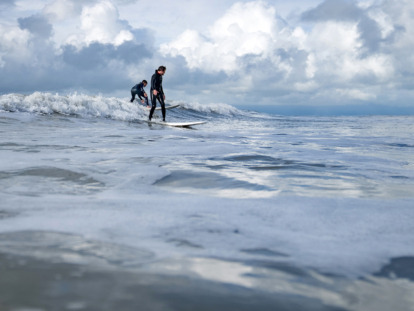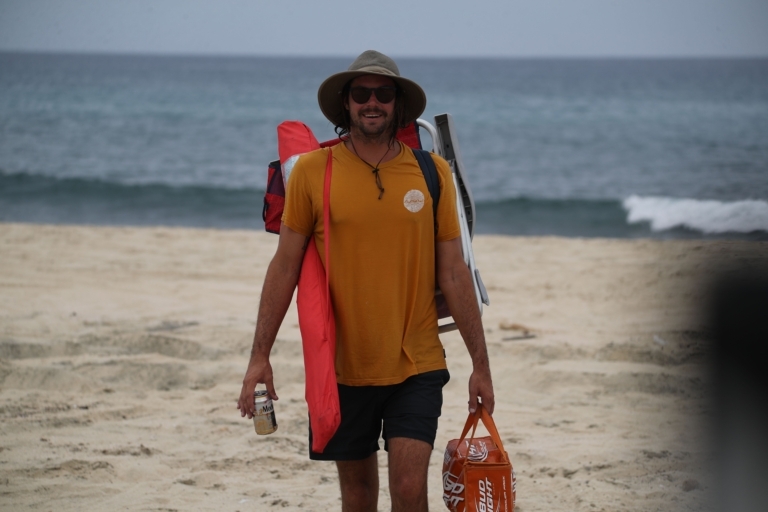Land of the Midnight Surf
Inside Yakutat Surf Club’s budding stoke scene in Southeast Alaska.
“Oh, you have to wave,” Chelsea Jolly, who helped start the Yakutat Surf Club, politely tells me as I drive past a red sedan.
“Huh?”
“Everyone waves,” says the Oregonian photographer, filmmaker and environmentalist.
She tells me that the “Yakutat wave” is required while in town if you don’t want to be rude. Everyone does it—tractor drivers on dirt paths, kids on bikes, parents pushing strollers, the guy outside the bar, the guy outside the mini-mart, the girl with the red-and-black-dyed hair foraging for salmonberries on the side of the road. Everyone. While this friendly wave isn’t unique to Yaakwdáat (Yakutat), Alaska, at the very least it’s a good reminder that if you’re from out of town and plan on indulging in a region’s natural resources, acknowledging your fellow humans is not a bad place to start.
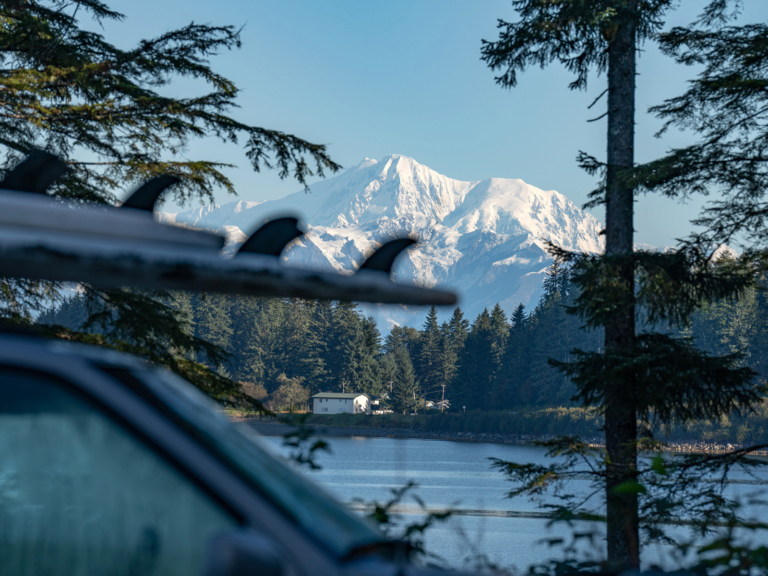
Pre-surf views of the second highest mountain in the United States, Mount Saint Elias or Yasʼéitʼaa Shaa—meaning “mountain behind Icy Bay” in Tlingit. Photo: Chelsea Jolly
While there are a few surf guide programs in the greater Alaskan state where you can hire a boat to take you up the coast or to offshore islands to surf, a surf camp in Alaska is a novel concept to most. And there’s only one youth surf camp, Yakutat Surf Club, and it’s in this remote Southeast Alaskan town, a place that’s only accessible by boat or plane.
Less than 700 people live in Yaakwdáat—meaning “the place where canoes rest” in Tlingit—and the Indigenous Tlingit community makes up half that population. The Native youth counts for three-quarters of the youth population and, depending on which camp, 90–100 percent of Yakutat Surf Club. For these kids, surfing is something different. “Playing is new because our summer season is so based on harvesting,” Gloria Wolfe, the Tlingit leader of Yakutat Surf Club, tells me. “It’s a new thing for the Elders in our community to see because they would say they didn’t have time to play, there was too much work to be done.”
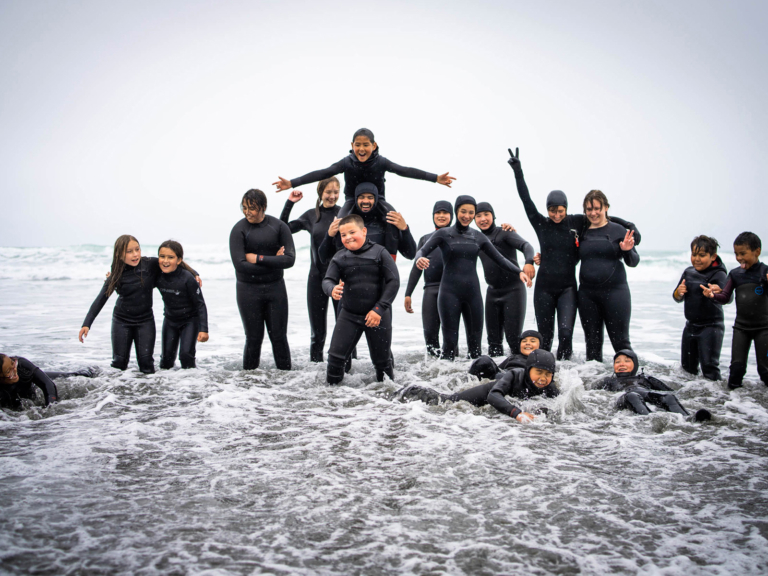
Ryan Cortes does more than hoist Yakutat Surf Club members on his shoulders. Photo: Bethany Sonsini Goodrich
Ryan Cortes ran the first unofficial Yakutat Surf Club in 2018. Originally from Puerto Rico, Ryan ended up in Juneau, Alaska, for college and didn’t leave. He’s a photographer, filmmaker, surfer and snowboarder. He’s the fire that lights the camp.
According to the veteran instructors, Yakutat Surf Club’s origin story differs slightly. Ryan and I spoke on the phone after the camp, and how it started wasn’t quite Ryan driving around town, yelling out his window and scooping anyone into his van who wanted to surf; but it wasn’t far off, either.
“I’d been going there for two years with my buddy, Dylan Quigley, one of my best Alaska friends,” says Ryan. “I noticed there were no kids surfing when we’d go, and I got the idea for the surf camp. So, I went on a trip with my girlfriend, Kaila. We just showed up, rented a van and drove to the surf shop, Icy Waves, and talked to the [then] owner Jack [Endicott]. I was like, ‘Do you know any kids that might want to surf?’ And Jack called his son Nate, who is a teacher, and the next day there were eight kids at the shop. I was asking them why they didn’t surf, and they told me they didn’t have access to the boards and wetsuits needed, or they had a cousin that had a bad accident while fishing and they were scared of the ocean.”
Jack lent Ryan and Kaila some gear, and they packed everyone into their rental and were off. “We had no waivers, no liability, no nothing, dude!” says Ryan. “All that stuff’s over my head. We just planted the seed, you know?” The kids who went to the first surf camp spread it throughout the neighborhood. Suddenly, these kids who have grown up on the water, fishing and hunting their whole lives, were starting to get psyched about surfing.
Prior to pulling it all together, Ryan met another filmmaker named Colin Arisman. “He was a huge catalyst for the project in the early stages. He’s got a company out there and helped bring on [fellow filmmakers and photographers] Chelsea [Jolly] and Sashwa [Burrous], who became huge parts of the camp that first year. They had connections and helped us get wetsuit donations,” says Ryan. “So, at the next camp the film crew came, and Chelsea got some paperwork and waivers together and became our logistical wizard and helped get it all organized.”
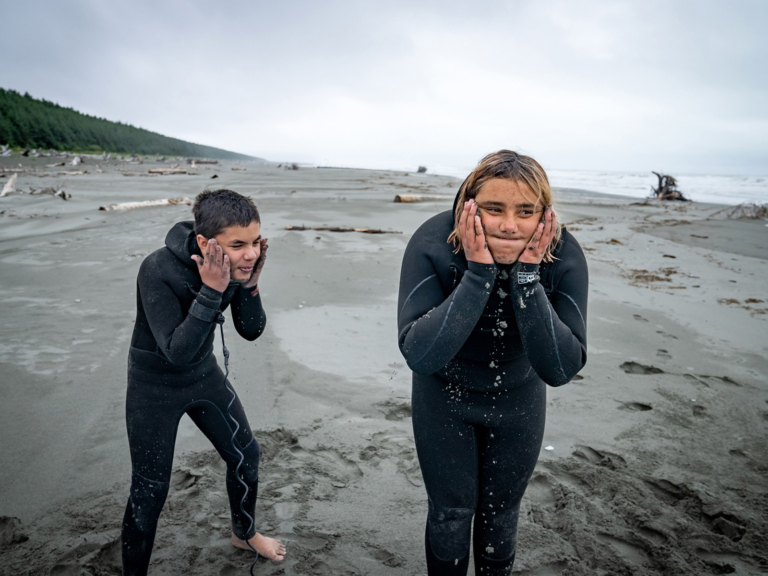
When in doubt, rub some sand on it. Photo: Chelsea Jolly
Ryan isn’t attending this weekend, but the Surf Club crew speaks of him in an almost mythic way. I start to understand the beacon of stoke that is Mr. Cortes when they show me an iPhone video which caught him on the beach, near a bonfire with his wetsuit top down, his fist pumping into his chest in Tarzan-fashion, bellowing out, “I CAN’T STOP SURFING!” to the kids’ and fellow instructors’ delight.
Ryan had a vision for the future of Yakutat Surf Club, and it wasn’t just taking a few kids out surfing for a couple days each summer. He wanted to give these kids the tools, skills and knowledge to surf their home breaks. When the camp started to gain traction, he looked for a local who could take it over.
“I found out about this lady that did suicide prevention in the area, and that’s how I found Gloria,” he says.
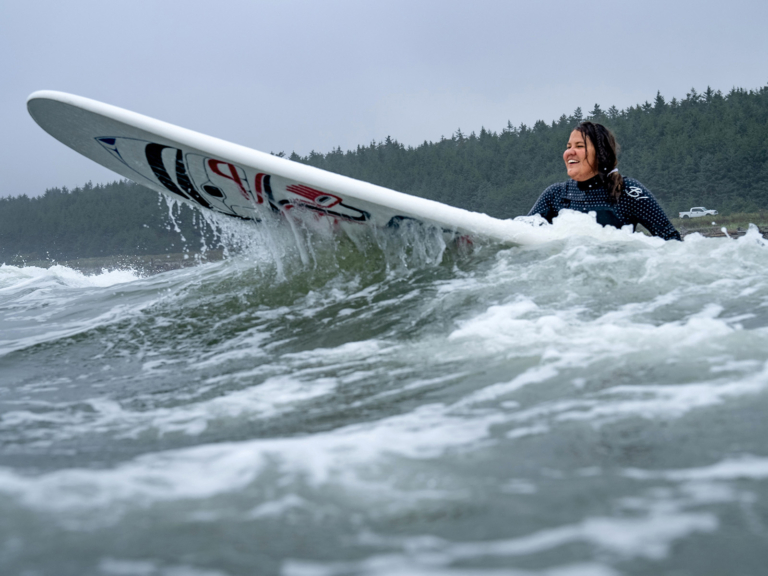
Gloria Wolfe makes her way into the lineup sporting a board with custom totem-inspired art made for Yakutat Surf Club by local Tlingit artist, Gyibaawm Laxha David Boxley. Photo: Chelsea Jolly
When I’d initially gotten in contact with Ryan about coming out, helping with the camp and writing this story, he told me I’d have to speak with Gloria, or “Momma Bear,” as he called her, first. Gloria is the Indigenous Leadership Continuum director for the nonprofit First Alaskans Institute. “We help develop young Indigenous leaders to be equipped and knowledgeable about the sovereign rights of tribes, the Alaska Native Claims Settlement Act and help them understand the full strength of their Indigenous identity, as well as the untold history of Indigenous experiences over the last 150 years of what was an essentially attempted genocide,” she says of her day job.
She and her husband Ralph Wolfe, who was Yakutat’s mayor at one point, run the camp today. They have two young boys: Jackson, age 11 and Jace, age 9. All four of them started surfing at camp with Ryan a few years ago and now are surfing as much as time allows.
Gloria brought the cultural component to the camp and became the catalyst for Ryan’s dream of teaching the kids in Yakutat how to surf their home waves. If it was going to work, and benefit the local community, their Tlingit culture would have to come front and center. “We are people of the water,” Gloria says. “We are people of the ocean. We’re people of the tides. We are canoe people. This is the place where canoes rest.”
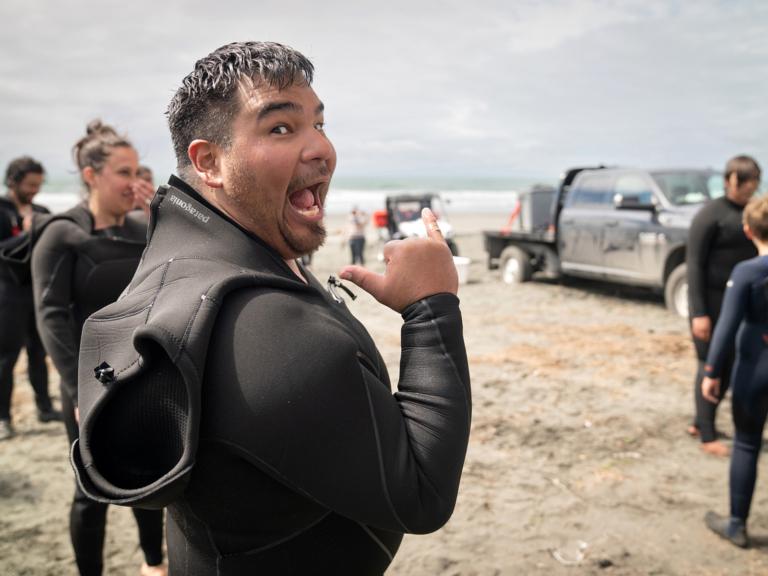
Ralph Wolfe blasts a shaka for the camera. Photo: Chelsea Jolly
Gloria is welcoming and discerning and loves her community deeply. She has an infectious, high-decibel laugh—the kind you can hear from across the shore, through 12-knot winds and a 4-millimeter hood. The kind that could be picked out of any room in any part of the world.
“All the kids here are family,” she tells me as we stand in the sand and rain, watching nearly 50 groms—ranging in age from 7–16—surfing, riding boogie boards and playing in the water. “Like, they’re all related. If not by blood, then they are by clan.”
Yet, Gloria is also a bit skeptical of outside interest in the camp and their culture. “We’re getting more and more visitors and people who are not from Yakutat into our camps,” she tells me. “That’s part of the reason that I think it’s so important to assert culture and identity. Because these kids knowing who they are, and knowing that this is Tlingit land, will help them be grounded in future arguments and future fights over whose land this is and how it is going to be kept sacred.”
Her skepticism is warranted. While colonization in most of North America began in the 16th and 17th centuries, the history and memory of it here are more recent. In the 1800s, when Russia led colonization in Alaska, Yaakwdáat was never claimed. “We chased them out of here. The only ones left to tell the story were anchored out on the ship that returned back to Russia,” Gloria tells me. “It’s told in our history. Then there was this transfer of Alaska from Russia to the US. By the time the Americans came here [during World War II], they had already done all their trials and errors of colonization through North America—they were a well-oiled machine. It happened in one generation.”
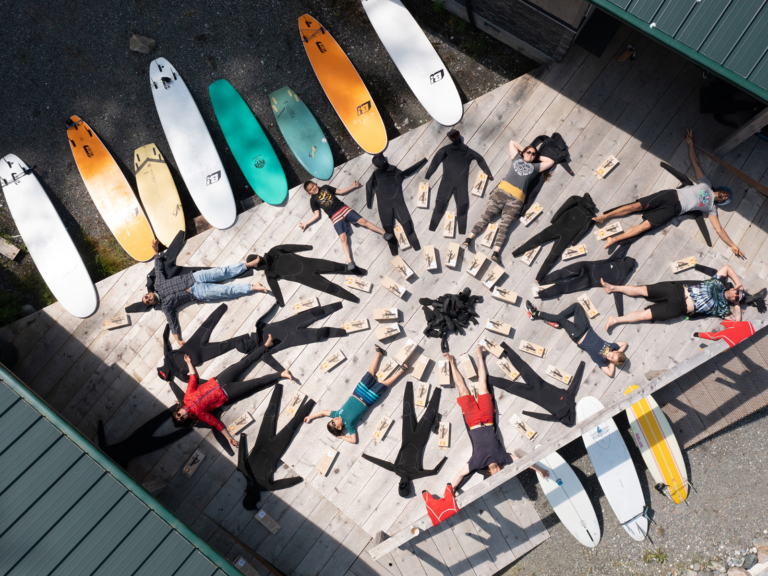
For the love of soft-tops and wetsuits. Photo: Chelsea Jolly
The Tlingit people weren’t moved to reservations like most Indigenous tribes. Instead, the generation who grew up during World War II fell victim to religious zealousness. “Yakutat became a stopover base for planes to fuel up on their way to the Aleutian Islands,” Gloria explains. “That’s why we have a huge runway for only 600 people. It was followed by religious takeovers in boarding schools. It was a really difficult time for Indigenous people because all of the children were removed from their homes [and sent to religious boarding schools].
“My grandmother was sent away to Wrangell Institute when she was 8. It’s so strange to think about entire communities with no children, like absolutely gone. That made it kind of hard to transfer knowledge. But somehow through all that chaos, there’s still so much that was transferred. My grandma taught my mom the Tlingit ways, which she taught me. Many of us were brought up without as much shame and guilt as previous generations. We do have intergenerational trauma to heal from the wrath of boarding schools.”
Gloria tells me that summers in Yakutat are traditionally for harvesting berries and fish. This summer though, between full-time work, putting on six surf camps, becoming a certified lifeguard and surfing every chance she gets, she says they haven’t gotten many berries and have only put two cycles of fish in the smokehouse. Although, one day before the camp started, Ralph took off to fish the Situk River and came back with a 4-foot-long cooler stuffed to the brim with sockeye salmon, five of which he fileted on his tailgate and cooked up to feed the Surf Club crew in the perpetually gray Alaskan evening.
In the few days I spent exploring before camp, I could see that learning to surf here is no easy task. Even making it to the coast is difficult without local knowledge. To get to most waves, you must navigate a labyrinth of dirt roads tucked away in the Tongass National Forest—to the untrained eye it all looks the same and one wrong turn could lead to hours of finding your way back home. Once you do find the breaks, they typically feature sub-50-degree water temps, heavy rains, gusting winds, shifting peaks and freight-train currents that when caught in, will have you out to sea or a mile-plus down the beach in a matter of minutes. Plus, you’re in grizzly bear territory, so it’s advised to keep your head on a swivel during your 15- to 20-minute walk back to the peak between the shore and dense forest line.
However, if anyone’s going to build a surf community here, it’s these kids. At lunch on the first day of camp, I’m in awe of the group who showed up despite the rain and windchill, put on their wetsuits and laughed their way through a morning of messy surf. I turn to Gloria who’s standing with a few fellow parents and friends, including lifeguards and instructors Janie Jensen and Violet Sensmeier, and say, “You’re built a little different up here.”
They all laugh in an eye-roll kind of way and almost collectively reply, “We know.”
There’s a tenacity and enthusiasm to the Tlingit youth that’s unlike anything I’ve seen while working at a surf camp, and I’ve worked quite a few. Each kid I pushed up a breaking wave’s face was undeterred. Knowing they were about to get smacked with some hard Alaskan ice water, they still came out the other side laughing and asking to get pushed into another one, “a BIGGER one!”
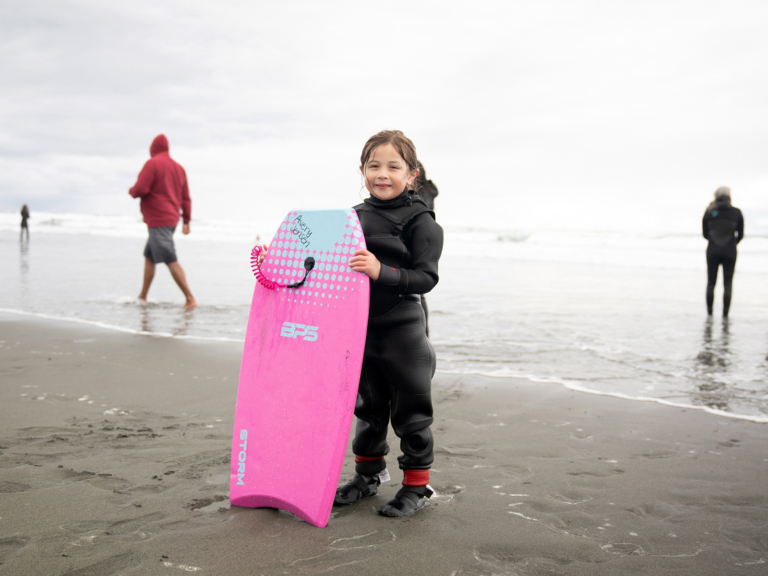
Yakutat’s youth are out there whether the suit fits just right or not at all. Photo: Chelsea Jolly
These kids have grown up around the ocean, in the rivers and in the forest; they learn to fish, hunt and forage at an early age. Jackson Wolfe, Ralph and Gloria’s eldest son, tells me, “Our dads and uncles usually take us on our first moose hunt when we are 8 or 9. I went on mine a couple years ago.” They can identify berries and fungus and dig the right roots for weaving baskets and bags on the way to their beaches and waves. They live off, and with, the land because it’s tradition, and partially because it’s hard and expensive to get provisions in Yakutat. Even their dogs take themselves on walks and come home with seeds strewn through their fur—they laugh about the time their dogs rolled in bear dung and how long it took to get the smell out.
Nellie Vale, a Surf Club member who’s been with the camp since the beginning, showed up in a 3/2mm wetsuit with no booties, no hood and a cup of coffee, unphased by the incessant downpour, the wind or the water temps, claiming the 5mm hooded suits provided by the camp are, in fact, “too warm.” These kids are a product of North America’s last frontier and stay in the water all day. No one is building sandcastles or chasing each other around the shore; instead, they are surfing, boogin’, bodysurfing or swimming.
The camp itself is run by people who don’t stop surfing and who love the water, the ocean and the drop-dead beauty that is Yakutat. They keep coming back for the kids, they teach and learn, simultaneously.
In the summer, it seems the sun never quite goes down. At night in July, there are three hours of darkness, which for some is for sleep while the rest is reserved for recreation. Around 11 p.m. on the night following the first day of camp, after we spent eight hours pushing kids into waves and had just finished stuffing ourselves with salmon, Gloria shouts out, “Alright, who’s coming surfing?”
So we clear out, hop in trucks and vans and head to the coast. We suit up and paddle out in a hue that makes me understand the true shade of midnight blue. Sitting on my board in the water, I watch the forest cast shadows that peak and valley over untracked sand and fallen trees—the area muted, still, stunned. Out of the water, on the way back to the truck, the actual threat of bears brings my feet near the waterline—keeping me paddling back out through semi-submerged rocks and into the ocean as a possible escape, if need be.
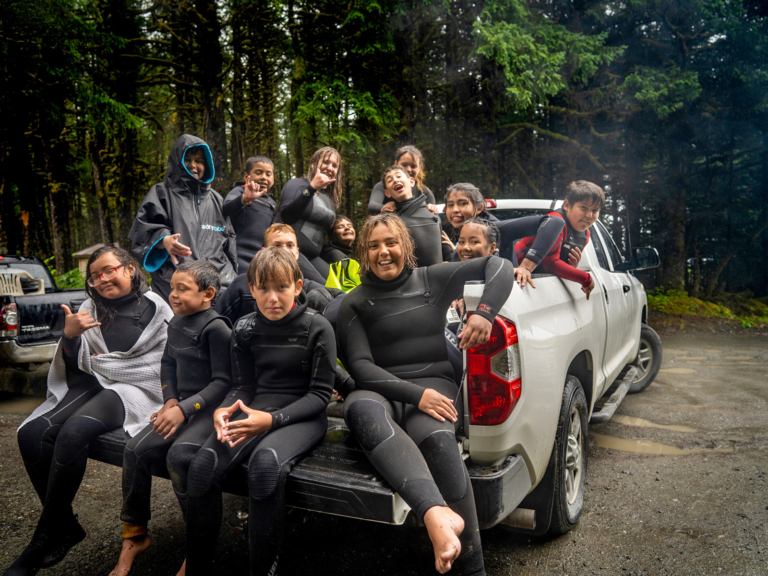
Truck’s taken. Photo: Chelsea Jolly
As camp evolves, teaching ocean safety and emergency medical intervention like CPR is a priority. The Yakutat Surf Club crew have brought on a team of volunteer coast guards, comprised of Rob Emly, Juan Espinosa Gomez and Tyler Conners, who are stationed in Sitka, Alaska. In the morning, on the beach before entering the water, the safety team gives a rundown of the currents, swell direction, height and how the water will move throughout the day. Considering the tides can swing up 12 feet, resulting in rapidly changing conditions, the kids listen intently. They know the ocean is powerful; they’ve heard stories or have lost family members to the water before.
I ask Gloria how surfing connects to their culture and its importance for the youth growing up. “The water means a lot to us as Indigenous people,” she says. “At camp, I’m able to stand at the water’s edge and talk to them about the power and strength of the ocean. For us, water has a spirit; everything has a spirit in terms of energy. The ocean is such a strong and sacred place that can’t be messed with. So, we go in with that mindset of respect and love. The water is a good way for us to communicate with our ancestors and our loved ones. It’s in our bodies. It’s who we are. We grow in our mother’s body in water, and the water has to be broken to be born into this new place. Bringing these ideals to our youth through surf camp has been a really good way to remind them, and myself, that we as Tlingit people no longer have to compromise ourselves in any space at all.”
Maybe most importantly, Surf Club is a way to improve the mental health of Yakutat’s youth.
“Depression is an issue here like anywhere else,” says Gloria. “But when it’s February and there are only three hours of sunlight each day, it’s harsh.”
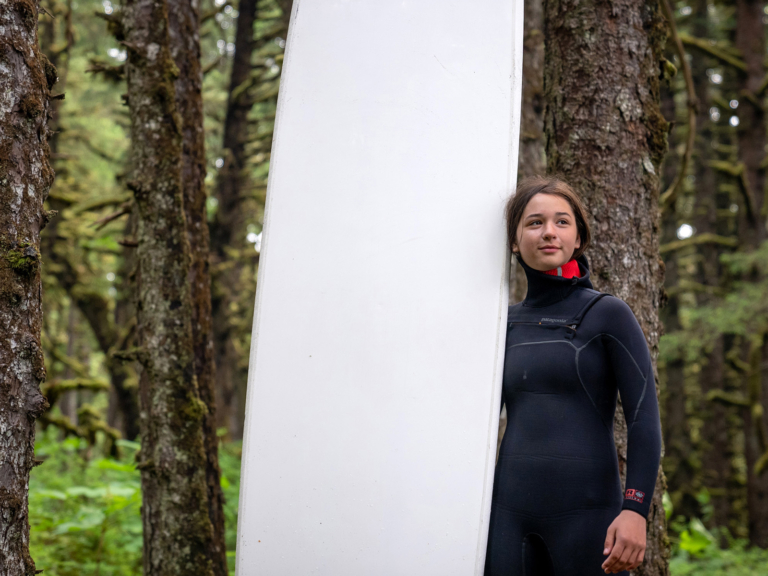
Yakutat Surf Club member Zoé Bulard among the trees. Photo: Chelsea Jolly
Gloria, Ralph, Ryan and Chelsea are working to start a nonprofit called the Heen Foundation (heen meaning “water” in Tlingit) whose goal is to facilitate healthy outdoor recreation for the locals, including Yakutat Surf Club, like canoeing and cross-country skiing in the winter months. “Because of a lot of intergenerational trauma and lack of outlets for Indigenous youth, improving mental health is a huge pillar within what we’re trying to do,” says Gloria. “The whole thing is about uplifting one another and staying together.”
On my last morning in Yakutat, the rain stops; the sun doesn’t shine, but there are a few hours between the next forecasted downpour. It’s time best used for one last trip to the coast before my flight, for a few more berries plucked on the way to check the surf. Gloria, Jackson and Jace join Chelsea and I; their dog Rosie stomps and frolics in the bushes and puddles, muddying up her white labradoodle curls.
The kids pick berries. Gloria asks them to do a “berry smash,” and after some convincing, they take a big handful of blueberries and salmonberries and smash them into their mouths. They smile and laugh—their teeth blotted with red and purple and black. “They give me energy and are protein-packed. They’re the best surfing snack,” Jackson tells us calmly in his usual considered, calculated manner while Jace giggles in the background, “They’re sour!”
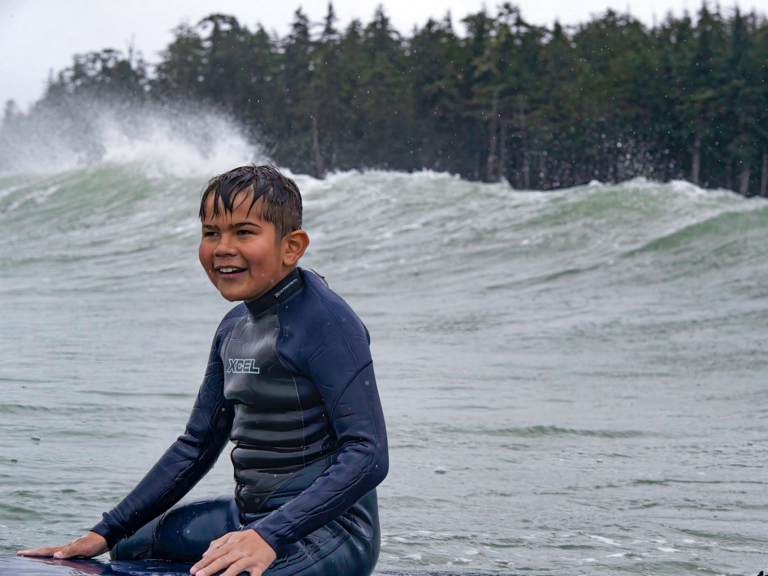
Out the back with Jackson. Photo: Ryan Cortes
I tell Jackson that they were ripping this weekend. “All the kids at Surf Camp dance,” he tells me. “That’s why we’re good at surfing. We have strong arms and legs.” He says they’re all part of the Mount Saint Elias dance group, where they do traditional Tlingit dances to songs that were written over 10,000 years ago. I ask him what his favorite part of being Tlingit is. “I don’t necessarily have a favorite part,” he says. “I just like being Tlingit overall. I’m just grateful for it.”
I ask him about the surf stoke and if he thinks he has it.
“Well, I’m pretty sure all of the people have the surf stoke right now,” he says. “There’s literally nothing in the world that can compare to riding a wave.”
If you’d like to support Yakutat Surf Club’s ongoing effort of connecting the local youth to their waves and beaches, head here to donate.
